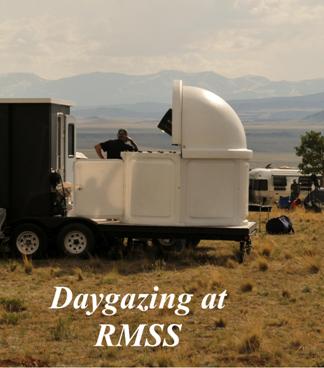Rocky Mountain Star Stare 2008
Dave Wagner
Last year my daughter and son-in-law decided to move out to Colorado Springs (and dared to take my gorgeous little granddaughter with them!). I took advantage of our recent visit with them, to take in the Rocky Mountain Star Stare (RMSS).
Location / Environment - RMSS is held in the Pike National Forest, to the northwest (64 miles as the crow flies, but 2 plus hours as the car drives) of Colorado Springs. You are located in the 'South Park' area. Between you and Denver lies the 'Front range' of mountains, and to the west of you lies the high and still snow capped Mosquito Range and the continental divide. The RMSS site was located up in a relatively flat, but high hill area (at 9,852 feet) with a gorgeous daytime views of the mountains and the valley below.
Camping is pretty basic for the event. Pack it in, pack it out. No water, so bring a lot (also needed due to the high altitude). Hot intense sun during the day, very cold and damp at night. Chem-toilets were located every 100 yards or so along the road. We were not allowed to drive more than one car length off the road, but there was plenty of room for everyone to find a spot. Not a lot of trees near the road, so most of the area had great horizon views. There was an event tent there for gathering for speaker events. And lots of dust.

The Pike National Forest covers one million acres, and while I have not been to a prior event, it is possible this year's event was further north and west than prior years. Unlike the RMSS clear sky clock, which indicates 'blue' on it's darkness scale, this years site was in a brighter 'green' zone, probably primarily due to light pollution from Denver. More about that in a moment.
The Good - The hosting organization, the Colorado Springs Astronomical Society, has been conducting this event for over 20 years now. They were well organized as seen by the detailed email information they provided to help you prepare and then find the event.
Despite the ominous thunderclouds and high winds just before sunset on the first evening, as the sun went down the clouds wandered away as the wind died away. The temperature dropped quickly, and the sky continued to clear as it darkened. When I set up I made sure I had the best possible southern view to take full advantage of the additional southern latitude, and I wasn't disappointed. To the south, nothing but clear clear sky with the stars of the Milky Way observable down to the horizon. I had full, clear views of the entire Scorpius constellation. I spent a majority of my time on this first night with binoculars in hand, taking in the big picture and great southern views.
The Bad - Well, let's say 'not as good'. While I expected the nearly 10,000-foot altitude would some how wow me on 'transparency'... it did not. Perhaps it was my limited observing experience. Perhaps it was the July rainy season in Colorado that was putting a 'damper' on my expectations? Collimation? Just redid the collimation... No dew... Scope was well adjusted to the temperature... Or perhaps, it was that 10,000-foot whisper thin air that was causing the issue.
It seemed odd, but naked eye observing and binoculars wow'd me. When I took a look in my scope... my mental memory expected crisp bright clarity, but instead I had difficulty in picking up on dim details that I would recall from other dark sites. There seemed at times to be a school of shadowy fish maneuvering around inside my eyepiece, shimmering dark ghosts that were always moving and hiding the view. After leaning over and taking a lonnnng look into the eyepiece, it came to me, when I was forced to rapidly straighten up and gasped to refill my lungs with some air! My eyes were perhaps just not getting enough oxygen to support my night vision. Perhaps the local Colorado folks who are used to the altitude were able to take advantage of the 'thin' air, but for me, I felt I might have lost ground.
I did a bit of research on the web on the topic of high altitude and night vision. Different sources list 20% to 50% degradation of night vision at 10,000 feet. Pilots in non-pressurized aircraft were advised to use oxygen at night 'even at low altitude' to maintain good night vision. Given how precious night vision is to the astronomer, going to RMSS for the transparency had limited value for me. The skies would be better for photography than eyeballs from Lake County.
The Ugly - Overall RMSS was very good. The southern skies were great. Viewing was good, despite the thin air. Not the darkest dark site... the Denver and Colorado Springs area completely washed out the eastern horizon (not that I wandered my views from the south at all!). The eastern glow did 'lighten' the site quite a bit. You didn't need to worry about tripping in the dark walking to a bathroom break. Not a dark site nirvana, but definitely a good event. So what's the ugly? I only had two nights to observe... and on night two, while lying down in the tent for a rest, waiting for the sun to set... I heard the pitter-patter of rain on the tent. For me there would be no second chance to visit that grand southern view.
Published in the August 2008 issue of the NightTimes




